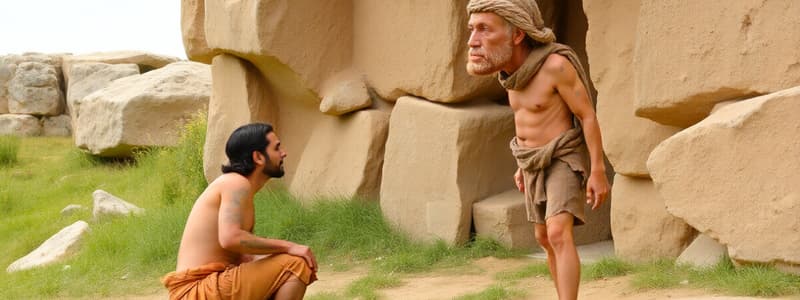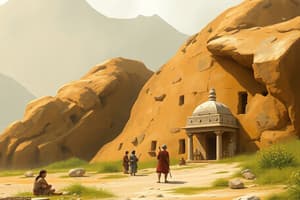Podcast
Questions and Answers
Approximately how many years ago did the Stone Age human originate?
Approximately how many years ago did the Stone Age human originate?
- 35,000 years ago
- 600,000 years ago (correct)
- 12,000 years ago
- 50,000 years ago
The Java Man, a possible early human species, is believed to have existed around the same time as what?
The Java Man, a possible early human species, is believed to have existed around the same time as what?
- The start of agriculture.
- The use of pottery wheels.
- The creation of rough stone tools. (correct)
- The creation of cave paintings.
Dr. Eugene Dubois discovered fossils of early humans in Java around what time?
Dr. Eugene Dubois discovered fossils of early humans in Java around what time?
- 1891-92 (correct)
- 1859
- 1920
- 1935
The use of stone tools by Paleolithic humans is evidenced around how many years ago?
The use of stone tools by Paleolithic humans is evidenced around how many years ago?
Approximately when did the Later Paleolithic Period begin?
Approximately when did the Later Paleolithic Period begin?
The Pleistocene Phase, also known as the Fossil Age, began approximately how many years ago?
The Pleistocene Phase, also known as the Fossil Age, began approximately how many years ago?
What is the term for periods with moist climate during the Ice Age?
What is the term for periods with moist climate during the Ice Age?
How many Ice Ages have been identified so far?
How many Ice Ages have been identified so far?
What marked a significant development in human settlement after 5000 BC?
What marked a significant development in human settlement after 5000 BC?
Around the same time villages started to appear, what invention was created for making pottery?
Around the same time villages started to appear, what invention was created for making pottery?
The study of India's ancient history began with the study of what?
The study of India's ancient history began with the study of what?
Darwin's 'Origin of Species' was published in what year?
Darwin's 'Origin of Species' was published in what year?
Around the same time that 'Origin of Species' was published, scientists discovered stone tools near Abbeville, France, alongside what?
Around the same time that 'Origin of Species' was published, scientists discovered stone tools near Abbeville, France, alongside what?
Who is credited with discovering cave paintings in the Kaimur hills in the Mirzapur area in 1880?
Who is credited with discovering cave paintings in the Kaimur hills in the Mirzapur area in 1880?
In what journal did Cockburn publish his illustrated account of his research in 1883?
In what journal did Cockburn publish his illustrated account of his research in 1883?
Flashcards
Stone Age Origins
Stone Age Origins
Early humans started using stone tools around 600,000 years ago.
Java Man
Java Man
Java Man is an early human type with ape-like features, dating back to the same period.
Paleolithic Humans
Paleolithic Humans
Around 50,000 BCE, humans used stone tools during the Fourth Ice Age.
Pleistocene Phase
Pleistocene Phase
Signup and view all the flashcards
Glacial and Interglacial Periods
Glacial and Interglacial Periods
Signup and view all the flashcards
Agricultural Revolution
Agricultural Revolution
Signup and view all the flashcards
Potter's Wheel Invention
Potter's Wheel Invention
Signup and view all the flashcards
Copper Age
Copper Age
Signup and view all the flashcards
Early Stone Age finds (India)
Early Stone Age finds (India)
Signup and view all the flashcards
Indian Prehistory Studies
Indian Prehistory Studies
Signup and view all the flashcards
Asiatic Society of Bengal
Asiatic Society of Bengal
Signup and view all the flashcards
Darwin's Influence
Darwin's Influence
Signup and view all the flashcards
D.H. Gordon discovers rock art.
D.H. Gordon discovers rock art.
Signup and view all the flashcards
Dawn of civilisation.
Dawn of civilisation.
Signup and view all the flashcards
Stone Age definition
Stone Age definition
Signup and view all the flashcards
Study Notes
-
Stone Age began roughly 600,000 years ago
-
Approximately 100,000 years later, humans started crafting crude stone tools
-
Fossilized remains of these tools have been discovered in various countries
-
It is hypothesized that Java Man in Asia originated during this era
-
Physically resembled apes
-
Named Pithecanthropus which translates to "ape-man" in Greek
-
Dr. Eugene Dubois located fossilized remains in Java in 1891-92, marking the beginning of studying man's development
-
Evidence suggests humans began using stone tools around 50,000 BC, during the fourth Ice Age
-
People from this time are referred to as Palaeolithic Man
-
The Upper Palaeolithic Period commenced roughly 35,000 BC
-
The Aurignacian era started within this epoch at 30,000 BC, and has abundant fossil evidence
-
It is also known as the Pleistocene Phase
-
Represents the end of the fourth glacial period
-
The Earth's northern hemisphere had alternating cold and warm periods
-
The southern hemisphere experienced alternating wet and dry climates
-
This phenomenon is called Ice Age and Interglacial Periods, with wet climates classified as Pluvial Periods
-
Evidence of 4 ice ages and 3 interglacial periods have been discovered so far
-
Five ice ages have been identified in northern India
-
Their impact stretched into Southern India
-
Northern Indian epochs correlate with East Asia
-
Southern Indian epochs link to Western Europe and Africa
-
Prehistoric human history is intimately tied to these ice ages
-
Tools found from each era are globally consistent across different human societies
-
From 50,000 BC, Palaeolithic humans began using primitive stone implement
-
From 35,000 BC, marks the Late Paleolithic Age
-
From 30,000 BC, the Aurignacian Era occurred
-
From 15,000 BC, the Middle Stone age period
-
From 10,000 BC, a New Stone Age, marked by handmade pottery, and sharper tools/weapons
-
From 5,000 BC, marks the Bronze Age, with potter's wheel etc
-
2,000 BC a time when iron was being used
-
Remnants of the early Stone Age have been discovered in the Son Valley
-
More were found in the Kurnool district of Madras
-
Examples were also found in Srinagar, Kashmir, and the Andaman Islands
-
More developed Stone Age relics have been discovered across numerous locations
-
Artwork from this era exists as prehistoric rock art
-
The study of India's early history started with foreign scholars' interest in Vedic literature
-
Credit for focusing on Indian prehistoric art goes to the European interested in the country's mysterious art and culture
-
The Asiatic Society of Bengal was founded, enthusiastically starting historical investigations
-
The work was limited to literary research
-
Difficult terrain hindered discovery/study of prehistoric India
-
Discovery of prehistoric art took time
-
Excavation work for the Sindh civilization was uncovered during railway construction from Karachi to Lahore
-
Events in Europe marked the beginning of the concept of prehistoric man
-
Darwin's work "Origin of Species" in 1859
-
Sir John Evans, Falconer, and Prestwich discovered stone tools made by prehistoric man
-
Fossils were found near Abbeville, Europe
-
Publication of Lyell's article "Geological evidence ofantiquity of man" in 1863
-
Theory suggests common prehistoric human cultural evolution
-
Although India had transport in the 19th century, there was little progress in finding prehistoric India
-
Real progress was only made after 1920
-
In 1922, under the supervision of Sir John Marshall, the excavation of Harappa was started by Shri Dayaram Sahni
-
Continued until 1934
-
During 1926-28, excavation of Balochistan strengthened the concept of the spread of the Sindh civilization
-
Sir Orl Stein and Hargreaves gathered evidence
-
From 1927-31, Shri N.G. Majumdar and Rakhal Das Bandyopadhyay
-
Miles Burkitt and Yale & Cambridge Universities began work
-
Interest grew in prehistoric rock paintings
-
A decade after the first research on prehistoric paintings in Spain and France, the discovery of rock paintings in India began
-
Carlisle and Cockburn share the credits for this
-
In 1880, Carlisle found cave paintings in the Kaimur hills near Mirzapur
-
He did not publish images
-
Discovery of the rhinoceros hunting scene which was published also
-
Karkaban has a second article in 1889 edition of Journal of The Royal Asiatic Society
-
Includes replicas of cave paintings from Bhaldaria, Lohri, and Lakhaniya
-
They believe that the best artwork took place in the rock shelters of the southern Kaimur range
-
F. Faucett published in 1892 details of prehistoric paintings discovered near Bellary
-
In 1901, they introduced the Edakal cave paintings
-
These existed as Rock Carvings
-
C.A. Silvarad published a descriptive article on the rock paintings of Banda district in 1907
-
Published line drawings of horsemen on foot and bullock carts without wheels
-
Thought the paintings were about 3000 years old and may have been linked to the New Stone Age
-
In 1910, C.W. Anderson discovered the major rock paintings of Singhanpur
-
Percy Brown mentioned it in the first edition of his Indian Painting printed in 1917
-
Compared prehistoric places art from other countries
-
Details were published in Panchanan Mitra's Prehistoric India in 1923
-
Stone pieces tested proved the art was ancient
-
Artwork locations consist of:
-
Mirzapur area
-
Banda area
-
Raigarh area
-
Panchmahdi area
-
Hoshangabad area
-
Bhopal area
-
Caves in the area that are painted are:
-
Writing 1
-
Writing 2
-
Lohri
-
Khodava
-
The value of this area is enhanced greatly by the paintings
-
The Kaimur Hills, where Indian cave paintings were first recognized, are situated in this very region
-
The cave's interior ceiling and walls are adorned with diverse depictions of hunting scenes, animal images, and dance-music scenes, illustrating the early inhabitants
Studying That Suits You
Use AI to generate personalized quizzes and flashcards to suit your learning preferences.




